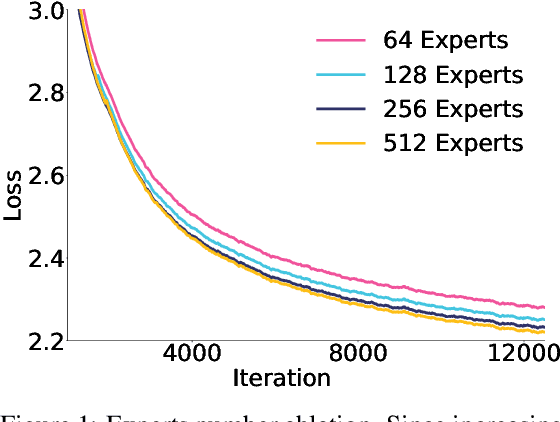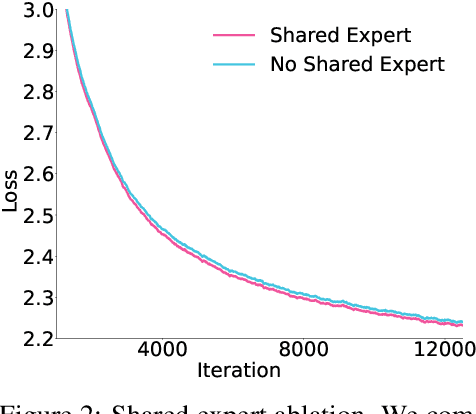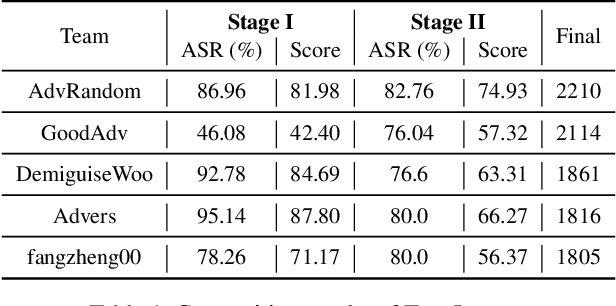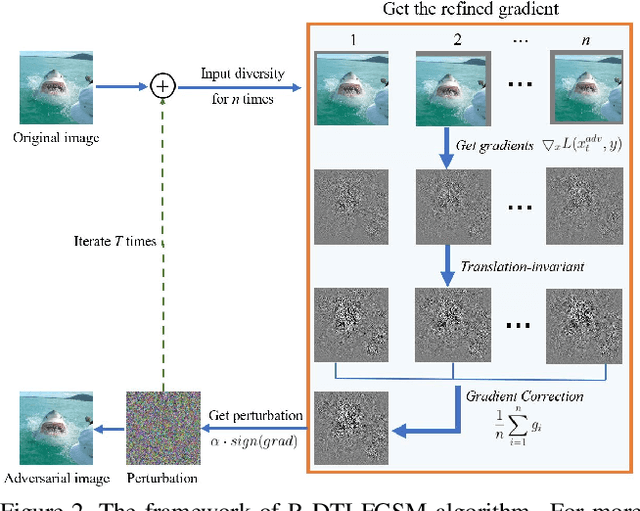Fangcheng Liu
and Other Contributors
Pangu Pro MoE: Mixture of Grouped Experts for Efficient Sparsity
May 28, 2025Abstract:The surgence of Mixture of Experts (MoE) in Large Language Models promises a small price of execution cost for a much larger model parameter count and learning capacity, because only a small fraction of parameters are activated for each input token. However, it is commonly observed that some experts are activated far more often than others, leading to system inefficiency when running the experts on different devices in parallel. Therefore, we introduce Mixture of Grouped Experts (MoGE), which groups the experts during selection and balances the expert workload better than MoE in nature. It constrains tokens to activate an equal number of experts within each predefined expert group. When a model execution is distributed on multiple devices, this architectural design ensures a balanced computational load across devices, significantly enhancing throughput, particularly for the inference phase. Further, we build Pangu Pro MoE on Ascend NPUs, a sparse model based on MoGE with 72 billion total parameters, 16 billion of which are activated for each token. The configuration of Pangu Pro MoE is optimized for Ascend 300I Duo and 800I A2 through extensive system simulation studies. Our experiments indicate that MoGE indeed leads to better expert load balancing and more efficient execution for both model training and inference on Ascend NPUs. The inference performance of Pangu Pro MoE achieves 1148 tokens/s per card and can be further improved to 1528 tokens/s per card by speculative acceleration, outperforming comparable 32B and 72B Dense models. Furthermore, we achieve an excellent cost-to-performance ratio for model inference on Ascend 300I Duo. Our studies show that Ascend NPUs are capable of training Pangu Pro MoE with massive parallelization to make it a leading model within the sub-100B total parameter class, outperforming prominent open-source models like GLM-Z1-32B and Qwen3-32B.
Pangu Ultra MoE: How to Train Your Big MoE on Ascend NPUs
May 07, 2025



Abstract:Sparse large language models (LLMs) with Mixture of Experts (MoE) and close to a trillion parameters are dominating the realm of most capable language models. However, the massive model scale poses significant challenges for the underlying software and hardware systems. In this paper, we aim to uncover a recipe to harness such scale on Ascend NPUs. The key goals are better usage of the computing resources under the dynamic sparse model structures and materializing the expected performance gain on the actual hardware. To select model configurations suitable for Ascend NPUs without repeatedly running the expensive experiments, we leverage simulation to compare the trade-off of various model hyperparameters. This study led to Pangu Ultra MoE, a sparse LLM with 718 billion parameters, and we conducted experiments on the model to verify the simulation results. On the system side, we dig into Expert Parallelism to optimize the communication between NPU devices to reduce the synchronization overhead. We also optimize the memory efficiency within the devices to further reduce the parameter and activation management overhead. In the end, we achieve an MFU of 30.0% when training Pangu Ultra MoE, with performance comparable to that of DeepSeek R1, on 6K Ascend NPUs, and demonstrate that the Ascend system is capable of harnessing all the training stages of the state-of-the-art language models. Extensive experiments indicate that our recipe can lead to efficient training of large-scale sparse language models with MoE. We also study the behaviors of such models for future reference.
Kangaroo: Lossless Self-Speculative Decoding via Double Early Exiting
Apr 29, 2024Abstract:Speculative decoding has demonstrated its effectiveness in accelerating the inference of large language models while maintaining a consistent sampling distribution. However, the conventional approach of training a separate draft model to achieve a satisfactory token acceptance rate can be costly. Drawing inspiration from early exiting, we propose a novel self-speculative decoding framework \emph{Kangaroo}, which uses a fixed shallow sub-network as a self-draft model, with the remaining layers serving as the larger target model. We train a lightweight and efficient adapter module on top of the sub-network to bridge the gap between the sub-network and the full model's representation ability. It is noteworthy that the inference latency of the self-draft model may no longer be negligible compared to the large model, necessitating strategies to increase the token acceptance rate while minimizing the drafting steps of the small model. To address this challenge, we introduce an additional early exiting mechanism for generating draft tokens. Specifically, we halt the small model's subsequent prediction during the drafting phase once the confidence level for the current token falls below a certain threshold. Extensive experiments on the Spec-Bench demonstrate the effectiveness of Kangaroo. Under single-sequence verification, Kangaroo achieves speedups up to $1.68\times$ on Spec-Bench, outperforming Medusa-1 with 88.7\% fewer additional parameters (67M compared to 591M). The code for Kangaroo is available at https://github.com/Equationliu/Kangaroo.
Rethinking Optimization and Architecture for Tiny Language Models
Feb 06, 2024



Abstract:The power of large language models (LLMs) has been demonstrated through numerous data and computing resources. However, the application of language models on mobile devices is facing huge challenge on the computation and memory costs, that is, tiny language models with high performance are urgently required. Limited by the highly complex training process, there are many details for optimizing language models that are seldom studied carefully. In this study, based on a tiny language model with 1B parameters, we carefully design a series of empirical study to analyze the effect of each component. Three perspectives are mainly discussed, \ie, neural architecture, parameter initialization, and optimization strategy. Several design formulas are empirically proved especially effective for tiny language models, including tokenizer compression, architecture tweaking, parameter inheritance and multiple-round training. Then we train PanGu-$\pi$-1B Pro and PanGu-$\pi$-1.5B Pro on 1.6T multilingual corpora, following the established formulas. Experimental results demonstrate the improved optimization and architecture yield a notable average improvement of 8.87 on benchmark evaluation sets for PanGu-$\pi$-1B Pro. Besides, PanGu-$\pi$-1.5B Pro surpasses a range of SOTA models with larger model sizes, validating its superior performance. The code is available at https://github.com/YuchuanTian/RethinkTinyLM.
PanGu-$π$: Enhancing Language Model Architectures via Nonlinearity Compensation
Dec 27, 2023



Abstract:The recent trend of large language models (LLMs) is to increase the scale of both model size (\aka the number of parameters) and dataset to achieve better generative ability, which is definitely proved by a lot of work such as the famous GPT and Llama. However, large models often involve massive computational costs, and practical applications cannot afford such high prices. However, the method of constructing a strong model architecture for LLMs is rarely discussed. We first analyze the state-of-the-art language model architectures and observe the feature collapse problem. Based on the theoretical analysis, we propose that the nonlinearity is also very important for language models, which is usually studied in convolutional neural networks for vision tasks. The series informed activation function is then introduced with tiny calculations that can be ignored, and an augmented shortcut is further used to enhance the model nonlinearity. We then demonstrate that the proposed approach is significantly effective for enhancing the model nonlinearity through carefully designed ablations; thus, we present a new efficient model architecture for establishing modern, namely, PanGu-$\pi$. Experiments are then conducted using the same dataset and training strategy to compare PanGu-$\pi$ with state-of-the-art LLMs. The results show that PanGu-$\pi$-7B can achieve a comparable performance to that of benchmarks with about 10\% inference speed-up, and PanGu-$\pi$-1B can achieve state-of-the-art performance in terms of accuracy and efficiency. In addition, we have deployed PanGu-$\pi$-7B in the high-value domains of finance and law, developing an LLM named YunShan for practical application. The results show that YunShan can surpass other models with similar scales on benchmarks.
Towards Transferable Unrestricted Adversarial Examples with Minimum Changes
Jan 04, 2022



Abstract:Transfer-based adversarial example is one of the most important classes of black-box attacks. However, there is a trade-off between transferability and imperceptibility of the adversarial perturbation. Prior work in this direction often requires a fixed but large $\ell_p$-norm perturbation budget to reach a good transfer success rate, leading to perceptible adversarial perturbations. On the other hand, most of the current unrestricted adversarial attacks that aim to generate semantic-preserving perturbations suffer from weaker transferability to the target model. In this work, we propose a geometry-aware framework to generate transferable adversarial examples with minimum changes. Analogous to model selection in statistical machine learning, we leverage a validation model to select the optimal perturbation budget for each image under both the $\ell_{\infty}$-norm and unrestricted threat models. Extensive experiments verify the effectiveness of our framework on balancing imperceptibility and transferability of the crafted adversarial examples. The methodology is the foundation of our entry to the CVPR'21 Security AI Challenger: Unrestricted Adversarial Attacks on ImageNet, in which we ranked 1st place out of 1,559 teams and surpassed the runner-up submissions by 4.59% and 23.91% in terms of final score and average image quality level, respectively. Code is available at https://github.com/Equationliu/GA-Attack.
Unrestricted Adversarial Attacks on ImageNet Competition
Oct 25, 2021


Abstract:Many works have investigated the adversarial attacks or defenses under the settings where a bounded and imperceptible perturbation can be added to the input. However in the real-world, the attacker does not need to comply with this restriction. In fact, more threats to the deep model come from unrestricted adversarial examples, that is, the attacker makes large and visible modifications on the image, which causes the model classifying mistakenly, but does not affect the normal observation in human perspective. Unrestricted adversarial attack is a popular and practical direction but has not been studied thoroughly. We organize this competition with the purpose of exploring more effective unrestricted adversarial attack algorithm, so as to accelerate the academical research on the model robustness under stronger unbounded attacks. The competition is held on the TianChi platform (\url{https://tianchi.aliyun.com/competition/entrance/531853/introduction}) as one of the series of AI Security Challengers Program.
 Add to Chrome
Add to Chrome Add to Firefox
Add to Firefox Add to Edge
Add to Edge